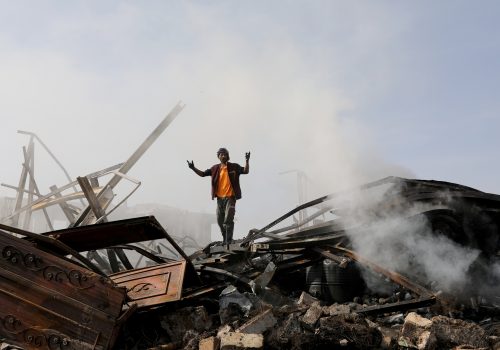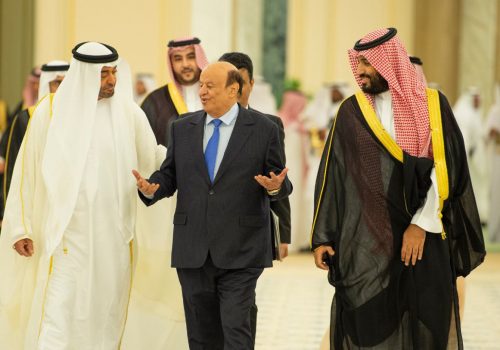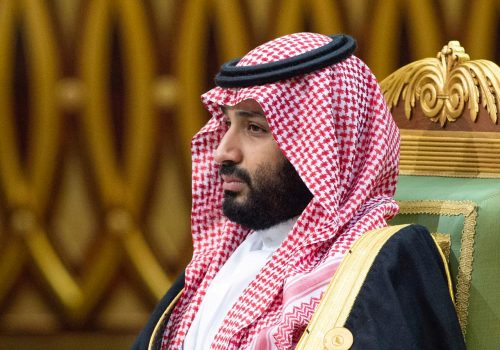The Biden administration’s Yemen imperative
Ending the war in Yemen, which has raged for the past six years, would fulfill two stated goals of the incoming Joe Biden administration: restoring the United States’ leadership role in international affairs and reducing tensions in the Gulf. In addition, it would be in the best national security interests of the US.
Former President Barack Obama’s administration sacrificed Yemen at the altar of achieving the 2015 nuclear agreement with Iran and securing short-term counterterrorism goals by heavily relying on the use of drones against al-Qaeda in the Arabian Peninsula (AQAP). The Donald Trump administration bought into the Saudi-Emirati argument that the Houthi rebels, acting as a proxy force for Iran, were intent on taking over Yemen to extend Iran’s influence to the Bab al-Mandab Strait and the Red Sea. The Arab coalition led by Saudi Arabia, which launched a war against the Houthis in 2015 in order to combat Iran’s “malign” influence, got the equation backwards. It was precisely the Saudi intervention—first in 2009-2010 on behalf of then President Ali Abdullah Saleh, and again in 2015 with the coalition’s war—that pushed the Houthis closer to Iran. What started as an internal struggle for power in Yemen has turned into a dangerous regional conflict that has only brought poverty, disease, and famine.
The Biden administration will have a chance to correct past mistakes by averting further destabilization of the region and by lifting Yemen from its current status as the world’s worst humanitarian disaster.
Mistakes of the past
There is no escaping the fact that Yemen descended into conflict starting in 2011 due to the failure of Yemeni parties to come to a new national agreement after the departure of President Saleh. The takeover of Sana’a by the Houthis invited a counter-invasion by the Arab coalition, which the Obama administration indirectly endorsed in 2015 and empowered via logistical and material support. These actions played a role in the destruction of Yemen while achieving none of the original goals of the civil war and Saudi-led intervention.
If this war continues for another year, or worse, if regional powers rush towards an end-game scenario, it will result in the total destruction of Yemen and the decimation of an entire generation.
From a national security perspective, former Secretary of Defense James Mattis and various Pentagon officials have expressed over the past several years that the Yemen war was not going to end in victory for either side. Rather, they warned, it was more likely to expand, putting at risk the very Gulf states involved and threatening to drag the US into a wider regional conflagration. During his stint as defense secretary, Mattis sought to use his influence to help bring the war to an end. He is often credited with having initiated the Stockholm peace talks, mediated by United Nations (UN) Special Envoy for Yemen Martin Griffiths at the end of 2018. However, Mattis, a military man, was not in charge of US diplomacy and the Trump administration had very little interest in investing much energy in ending the war. For his part, Griffiths has thus far lacked the superpower support he needs to succeed in his mission. This is where the incoming Biden administration can play a role.
Deconstruction of the Yemen conflict
The Yemen war has three interlinked components: internal, regional, and international. Ending the war will require a complex strategy dealing with all three levels.
Internal
The political transition, which was called for by the 2011 youth uprising, has stalled. Yemen’s descent into chaos started with the frustrated goals of that uprising: an end to corruption and the installation of a government that truly represents the Yemeni people and cares about their grievances. The National Dialogue Conference (NDC), which took place under UN auspices in 2013, brought together over five hundred delegates from various regions of Yemen, including representatives from civil society and political parties. As comprehensive as the charter that came out of the conference was, it had one major flaw: it failed to get the main power brokers around the country to negotiate a power-sharing agreement, which would be critical for a new political system in Yemen.
The balance of power in Yemen, though fragmented, is currently maintained between three major blocs. The Houthis are likely the strongest single bloc, with roughly one hundred thousand fighters and a massive arsenal of light, medium, and heavy weaponry. The Hadi government’s troops and loyalists, encamped largely in the Hadramawt region and further south in Abyan, add another one hundred thousand to the mix. Finally, the Southern Transitional Council (STC), which represents several but not all of the southern forces and is armed and trained by the United Arab Emirates (UAE), makes up a further one hundred thousand fighters, if all southern armies work together. These three blocs can be major power brokers in ending the fighting.
Critical for each power broker in any final peace agreement is their region’s political boundary, which was negotiated unsuccessfully in 2013. All blocs would like to include oil and natural gas facilities in Shabwa and Massila in their zone of influence. A final peace deal will have to ensure an equitable sharing of natural resources by way of undercutting unreasonable demands for territorial control.
Regional
The geography of Yemen, as a natural extension of the Arabian Peninsula with shores on the Arabian Sea and the Red Sea, tempts Saudi Arabia and the UAE to pursue their national commercial interests there. The Horn of Africa provides a desirable route for a potential Saudi oil pipeline from its oil fields directly to the Arabian Sea, circumventing, if need-be, the Strait of Hormuz. Access to ports in Aden and the Socotra Archipelago at the entrance to the Red Sea has similarly interested the UAE for years. These are natural stops along their shipping lane from Dubai to the Red Sea and the Suez Canal to the Mediterranean and Europe. This complements the UAE’s growing interest and involvement in the Horn of Africa, especially Eritrea and Djibuti .
As a result, Arab coalition cooperation in ending the war may be difficult to acquire, given the conflicting motives and interests. Nevertheless, Saudi commitment to reshaping Yemen to its liking has been deep and costly for the kingdom. Saudi Crown Prince Mohammed bin Salman may have overextended himself and state resources, resulting in budget cuts over the last couple of years. UAE leadership may also have felt overextended in Yemen, resulting in a withdrawal of most of its forces in 2019, although it left behind trained and equipped southern militias to act on its behalf.
Given those facts, cajoling and persuading Saudi Arabia and the UAE to cooperate in a Yemen peace effort would likely include promising them what they need rather than what they want. Clearly, both countries must be part of a maritime security agreement for the Strait of Hormuz and Horn of Africa. Fear of Iran—whether real, imagined, or contrived—is often posited as the first motivator for the use of force in Yemen by the Arab coalition. A broader US-Iran dialogue—assuming both sides agree to return to negotiations over the nuclear deal—should include Gulf Cooperation Council (GCC) countries so a case can be made directly to that forum. The two Arab coalition partners could also be convinced to join a mutual non-aggression pact with Iran, mediated by the US. Finally, Saudi leadership is worried, and rightly so, about continuous missile attacks from northern Yemen. A final peace agreement in Yemen could certainly include a non-aggression pact with its neighbors—perhaps a separate addendum to an internal agreement between the main Yemeni antagonists.
Working through armed proxies in a divided country will never protect the security and economic interests of Saudi Arabia and the UAE the way commercial agreements—buttressed by international security arrangements—might do with a peaceful and stable country. With this in mind, the Riyadh Agreement has led to a new cabinet under President Abdrabbuh Mansur Hadi, which, while currently lacking a Houthi element to make it a true unity government, is neither a step towards comprehensive peace nor a united military front preparing for a final assault on the north of Yemen.
International
The interests of Saudi Arabia, the UAE, and Iran, not to mention the US and Europe, are now intertwined with local interests. International actors, including European, American, and other arms exporters must be brought into an agreement to end the war via a moratorium on the export of arms to the region—at least for the duration of new peace talks and preferably through a successful end to such talks. A Yemen approach that encompasses all sides of the conflict must start with a commitment from the five permanent members of the United Nations Security Council (UNSC) to actively pursue an end to the war, starting with their sacrifice of revenue from arms sales and followed by a new unanimous UNSC resolution ordaining a coordinated diplomatic effort for peace in Yemen.
The US, which has more raw power and presence in the Gulf than any other nation, must lead this effort. For the incoming Biden administration, such an undertaking would fit in with the intended rapprochement with Iran, not only to restart the Joint Comprehensive Plan of Action, but to expand it into a broader understanding on conflict resolution in the region. Getting buy-in from the great powers should not be too difficult, as none of the other permanent UNSC members have a strong interest in Yemen and all would benefit from a more harmonious Middle East—if from nothing else than the safeguarding of international trade routes and oil shipments.
Urgent matters
As the Biden administration brings renewed focus on Yemen, an agreement on a country-wide ceasefire is an urgent first step, as the human cost of the Yemen tragedy is horrifyingly high and continues to climb. Given tensions in the Gulf, Yemen’s utility as a confrontation zone will only grow with time. The peace talks that follow a ceasefire must be managed closely by the Biden administration. Soon after, buy-in has to be obtained from the Arab coalition and, through them, the principal power brokers inside Yemen. Following peace talks, an urgent rescue plan must be internationally funded and implemented under the auspices of international institutions and civil society organizations. If fitted to the needs of various regions of Yemen, the plan can be an added incentive for the warring parties to come to terms quickly to benefit from the redevelopment of Yemen. The plan must also include the elements of good governance and a strong anti-corruption plan, which can bring back the educated youth who have fled the country and whose expertise will be sorely needed in helping to launch the new Yemen.
Turning the page in the Middle East requires new leadership and the deft management of complex files. Negotiating a new US-Iran relationship must involve several separate but related tracks, of which Yemen is a central part. Solving the Yemen conflict will help put the rest of the pieces of the larger Middle East puzzle back in place. Active involvement by the United States will be critical.
Nabeel Khoury is nonresident senior fellow at the Atlantic Council’s Rafik Hariri Center for the Middle East.
Image: A security personnel member reacts as dust rises after explosions hit Aden airport, upon the arrival of the newly-formed Yemeni government in Aden, Yemen December 30, 2020. REUTERS/Fawaz Salman



